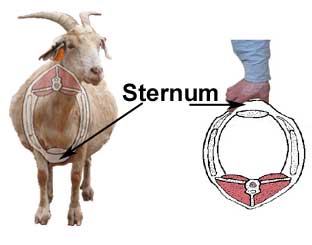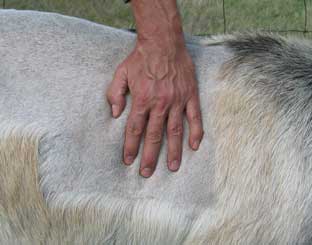How to Body Condition Score
Scoring is performed in goats using a BCS ranging from 1.0 to 5.0, with 0.5 increments. A BCS of 1.0 is an extremely thin goat with no fat reserves and a BCS of 5.0 is a very over-conditioned (obese) goat. In most cases, healthy goats should have a BCS of 2.5 to 4.0. Scores of 1.0, 1.5, or 2.0 indicate a management or health problem. Scores of 4.5 or 5 are rarely observed in goats under normal management conditions; however, these scores can sometimes be observed in show goats.
You do not have the Flash plugin installed, which means you are missing out on great interactive content. Download Flash.
Three areas are evaluated in assigning a BCS: the lumbar region, or area containing the loin muscle; the sternum; and the rib cage.
1. Scoring in the lumbar area is based on determining the amount of muscle and fat cover over the vertebrae. Lumbar vertebrae have a vertical protrusion (spinous process) and a horizontal protrusion (transverse process). Both processes are used in determining BCS. Run your fingertips over the spinous process to feel for the vertebrae. Try to grasp the spinous process between your thumb and forefinger. Use your whole hand to feel the loin muscle and fat cover. Try to slip your fingers underneath the tranverse process.



2. The second body area to feel is the fat covering on the sternum (breastbone). Scoring in this area is based upon the size of the fat pad on the sternum that can be pinched.


3. A third area is the rib cage and fat cover over the ribs.

Reference: Detweiler, G., T. Gipson, R. C. Merkel, A. Goetsch, and T. Sahlu. 2008. Body Condition Scores in Goats. Pages 127-133 in Proc. 23rd Ann. Goat Field Day, Langston University, Langston, OK.
